
“A wise man speaks because he has something to say, a Fool speaks because he has to say something.”
-Ancient Proverb
The first piece of fitness equipment I ever owned was a pull-up bar. I got it when I was thirteen years old and installed it in the doorway of my bedroom. Since I was so light, I was actually able to do a couple of chin-ups right away. (Chin-up is the technical name for a pull-up done with an underhand grip.)
Though the trusted pull-up has always had a place in my workout regimen, over the years I’ve spent a lot of time seeking out new innovations and experimenting with different training modalities in an attempt to progress my fitness. My desire to find the perfect workout led me to try barbells, dumbbells, kettlebells, weight machines, cable machines, stability balls, medicine balls, sandbags, jump ropes, and anything else I could find. Surely there had to be a machine or some kind of wobbly device that could get me in peak physical condition. But alas, I’ve come full circle in my training, leaving behind all the weights, machines and other “innovations” in favor of training my upper body with nothing but the bar and my own bodyweight.
The pull-up is my all-time number one favorite exercise simply because it’s the purest way to measure or train pound-for-pound strength. Pull-ups are the great equalizer, putting the little guys on a level playing field with the big boys. They are the source from which all bar calisthenics are borne.
No matter how strong you think you are, pull-ups can be humbling. The bar can be your best friend or your worst enemy - that’s up to you. It’s better to be quiet and let your actions speak for themselves. Remember that no matter how far you go on your journey, there is always uncharted land ahead. Nobody is the best at everything and the world of bar training is bigger than you might think. Ignore those who may offer advice but fail to back it up in their performance. You can watch all the calisthenics videos in the world, but until you get under the bar and really start pulling your weight around, you’ll never understand what it’s all about.
Females can be especially intimidated by the bar, but let me assure you, women can do pull-ups! It might be a little more work for the ladies, but it is within the potential of every able-bodied woman to perform a pull-up.
Some women may be concerned that pull-up bar training will make them too muscular. I can’t tell you how many times I have heard this myth perpetrated. Being afraid that pull-ups will make you too muscular is like being afraid that reading books will make you too smart; it’s really just an excuse for those who aren’t willing to make the effort. Sadly, this misguided notion prevents many females from achieving their potential.
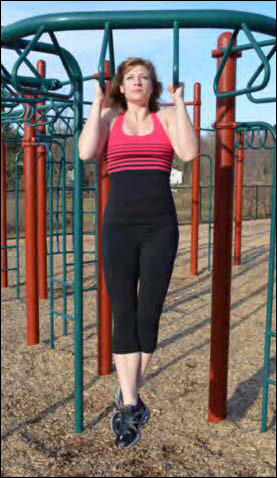
That’s right, ladies - anyone can do pull-ups!
The truth is, most women don’t have enough natural testosterone to gain muscle easily. It takes time for females to build the strength to do pull-ups (and the muscle that comes with it). Overly muscled women are either a genetic anomaly or taking artificial “enhancements.” Your natural body type is what it is, pull-ups will only help you get stronger and leaner. I’ve had a lot more clients quit over the years because they couldn’t hack it than because they had gotten too muscular.

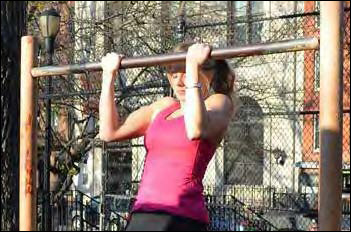
Regardless of gender, if you aren’t strong enough to do a pull-up yet, fear not - a pull-up bar is still the best piece of fitness equipment you could ever own. As you work your way up to your first pull-up, you can use the bar to help you get there.
There are three primary exercises that you can do on an overhead bar as a precursor to a pull-up: flex hangs, negatives and dead hangs.
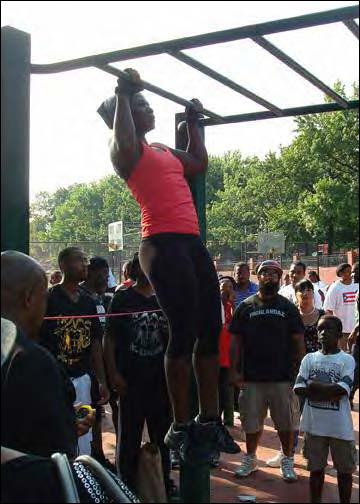
All of these women do pull-ups, yet we see a Variety of body types.
A flex hang involves holding yourself at the top of a pull-up with your chin over the bar. It is best to start using an underhand (chin-up) grip. Use a low bar, a bench or a partner to help you get in position and then simply try to stay up. Use your arms, your back, your chest and even your abs to help maintain this position. Think about squeezing every muscle in your entire body. This concept of creating total body tension is essential for many of the exercises that are performed on the bar. The flex hang is a wonderful way to begin developing that ability. If you can hold this position for even a second on your initial attempt, you are off to a good start.

Hang in there, girl!
Once you can hold the flex hang for several seconds, you’re ready to start working on negative pull-ups, which just means lowering yourself down slowly from the top position. In the beginning, it might be very difficult to perform a controlled negative, but with time you will be able to make your negative last for ten seconds or longer. Though you want to make the rep last for as long as you can, don’t try to move in slow-motion, instead think of lowering yourself at a normal speed and freezing for half of a second every inch of the way down. This will help you stay in control. Imagine a photographer is trying to take a series of photos and you need to be still during each shot.

Start off at the top of the pull-up position.
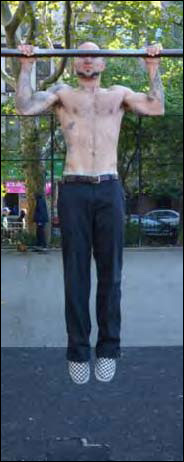
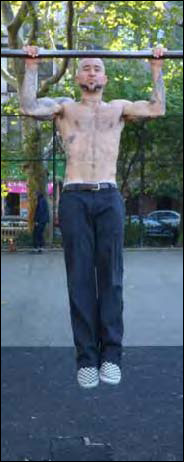
Think of lowering yourself at a normal speed and freezing for half of a second every inch of the way down.
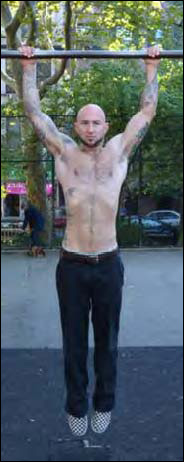
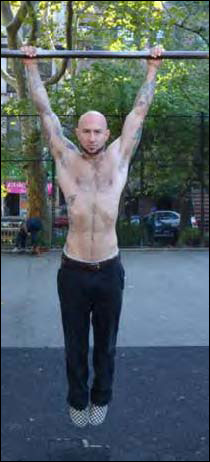
Imagine a photographer is trying to take a series of photos and you need to be still during each shot.
If you are not strong enough to do a flex hang or a negative yet, your first objective is simply to get a feel for hanging from the bar. This will build grip strength and work your lats and shoulders isometrically. With some practice, you should be able to work to a flex hang fairly quickly. Even once you can perform flex hangs and controlled negatives, it is still helpful to practice dead hangs at the end of your training session when your arms have gotten too fatigued to do more negatives.
When you perform a dead hang, avoid shrugging your shoulders. Think about keeping your chest up while pulling your shoulder blades down and back. This is both safer and more effective.

Think about keeping your chest up while pulling your shoulder blades down and back.
It is important to note that overweight and obese individuals will have a much harder time with all bodyweight exercises, especially bar calisthenics. Once you get your body fat percentage into a healthy range, pull-ups (and life in general!) will become much more manageable.
The Australian pull-up (or bodyweight row as it’s sometimes known) is a great exercise for someone who is working their way up to a standard pull-up. The Australian involves getting “down under” a bar that is a little above waist height, with your feet resting on the ground. Keep a straight line from your heels to the back of your head as you squeeze your shoulder blades together and pull your chest to the bar. Novices may choose to bend their knees and push gently with their heels in order to give their arms assistance if needed. When you get a little more comfortable with this exercise you can angle your heels to the floor with your feet pointed up and your legs straight. Like a standard pull-up, the Australian tends to be a bit easier with an underhand grip, though I believe there is more benefit for beginners to practice the overhand version once they are strong enough.

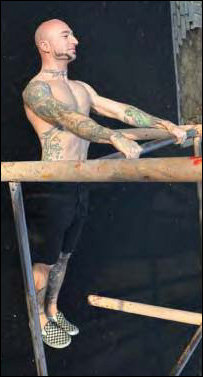
Novices may choose to bend their knees and push gently with their heels.
Just like the dead hang, be sure that you are not shrugging your shoulders up when performing Australians. You want to pull your shoulder blades down and back - never up. This is the case for all pull-ups. Start getting in the habit of doing this right away - it’s the most common error I see people make when performing these moves.

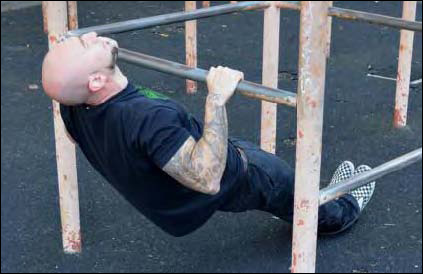
You want to pull your shoulder blades down and back - never up.
Once you are strong enough to do lot of Australian pull-ups and negative pull-ups, you will be ready to start working on chin-ups. As with the flex hang, it is easier for beginners to start with an underhand grip first.
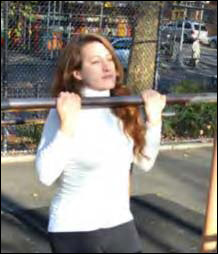
Chin it to win it.
If you’ve gotten pretty good with Aussies but you still can’t manage a single pull-up, here’s something to practice. Get under the bar with your feet resting on a step or bench (or use a lower bar if you have access) so you can grab the bar overhead with your feet flat and elbows slightly bent. From here, you can assist yourself by jumping into the pull-up. Jump as hard as you can and in time you will be able to initiate the movement with a smaller jump and eventually without jumping at all.
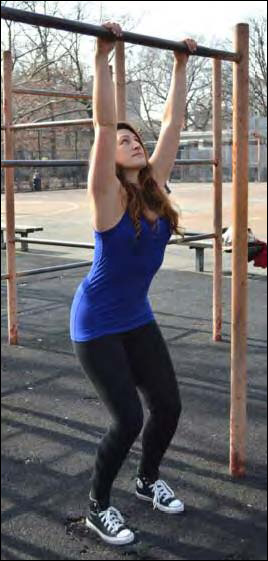
Might as well jump!
Having a trainer or training partner to spot you can be very helpful while you are learning to do pull-ups, just make sure they don’t do too much of the work for you. I find it best to spot someone on their back rather than holding their feet as it allows me to adjust how much help I am giving them.
You might need a little extra help initiating the movement as well as during the last few inches, but the idea is for the spotter to make you really work for it. It is important to discuss this with your workout partner to make sure you are on the same page. If they’re giving you too much help, you’ll never build up the strength to do it on your own.
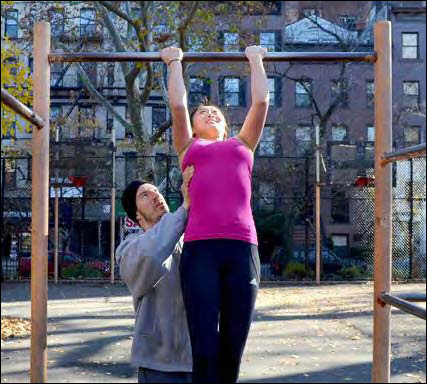
I find it best to spot someone on their back rather than holding their feet.
One more thing, steer clear of assisted pull-up machines that allow you to rest your body on a platform. They provide too much stability and therefore do not require the core strength needed for an actual pull-up. You’ll never build to the real deal with this type of machine. Beginners who don’t have a spotter are better off practicing pull-ups using a rubber exercise band.

If you don’t have a spotter, a rubber band might be your best bet.
After you can do a dead hang chin-up, you may begin training for the classic pull-up (overhand grip just wider than shoulder width). You may need to go back a step and practice flex hangs and negatives with an overhand grip in order to prepare your body for a pull-up, as you won’t be able to use your biceps as much as you do with the chin-up.
When you use an overhand grip, you’ll need to engage your lats as the primary mover. It is for this reason that beginners who can do several chin-ups will still often struggle with the pull-up. Though the lats can potentially become bigger, stronger muscles than the biceps, deconditioned individuals are more likely to have some bicep strength from everyday activities, while their lats will be nowhere near their full potential.
The key to overcoming this is not to think of the pull-up simply as an arm exercise. Your lats are doing the bulk of the work, followed by your shoulders, chest and abs. Rather than simply focusing on pulling your chin past the bar, think about squeezing your whole body tight and pulling your elbows into your sides while keeping your chest up. This will help you recruit more of your muscles. Remember the concept of total body tension discussed earlier. When you are performing a pull-up you must keep your body rigid. The pull-up is actually one of the best abdominal exercises out there. Beginners are often surprised at how sore a day of pull-up training can leave their abs. I give the credit for my defined midsection to pull-ups and hanging leg raises (more on those in chapter 3). I haven’t done crunches in years and I have no plans of ever doing them again.

Pull-ups give you abs!
Most standard pull-up bars are one inch thick. The bars at Tompkins Square Park are one and a half inches thick.
The best bar to train on is a plain-old no-frills straight metal bar. You don’t need rubberized handles and you don’t need ergonomic angled grips. The less fancy your pull-up bar is, the better. My favorite bars to train on are the one at Tompkins Square Park in NYC and the one that my brother Danny and I built in his backyard in Brooklyn.
When training pull-ups, bear in mind that the thickness of the bar will effect your strength. Pull-ups on thick bars require increased grip output and will fatigue your muscles quicker, so I would suggest beginners start with thinner bars. However, for an intermediate or high level trainee, thick bars can be beneficial for building grip strength.
Most standard pull-up bars are one inch thick. The bars at Tompkins Square Park are one and a half inches thick. The bars my brother Danny and I built in his backyard are two inches thick. We train hard in Brooklyn!

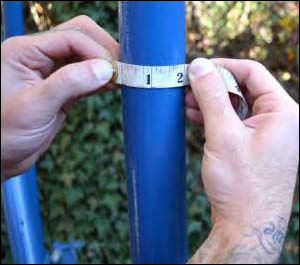
The bars my brother Danny and I built in his backyard are two inches thick. We train hard in Brooklyn!
When you grip a fat bar in the normal wrap-around fashion, your thumb won’t make it all the way around unless you have very large hands. For this reason, the hook grip will allow most people to get a more solid grasp. Hooking your thumb against your index finger lets you keep your hand together tightly. Your grip is stronger this way. I actually suggest practicing with a hook grip regardless of the thickness of your bar. A quick look at these photos should show you what I mean:

Though supinated (underhand) and pronated (overhand) grips are the two most common ones used for pull-ups, there are other types of grips that you can experiment with. Using two bars that are parallel to each other instead of one straight bar allows you to put your hands into a neutral position with your palms facing each other. Some people will find this to be a nice intermediary step between the underhand and overhand grips. We all have our unique strengths and weakness, so I urge you to practice each of these three primary grips (underhand, overhand and neutral). With repetition, the pulling power of the lats will eventually surpass that of the biceps, which will help even out the disparity of difficulty between various grips.

Hooking your thumb against your index finger lets you keep your hand together tightly.
Try to avoid the temptation to move onto harder exercises until you can perform at least ten reps of the previous movement. Even once you can do twenty or more reps of a given exercise in one set, it is still worthwhile to keep training that exercise. I’ll always keep pull-ups and dips in my workouts.

A neutral grip pull-up is performed with the palms facing each other.
The idea that strength and endurance are on opposite sides of the spectrum is not always the case. The guys who perform feats like one arm pull-ups and front lever holds are often the same guys who can do 25+ pull-ups in one set. Never stop training the basics - pull-ups should be a part of everyone’s training regimen. Without a solid foundation, even the tallest building would easily crumble.
